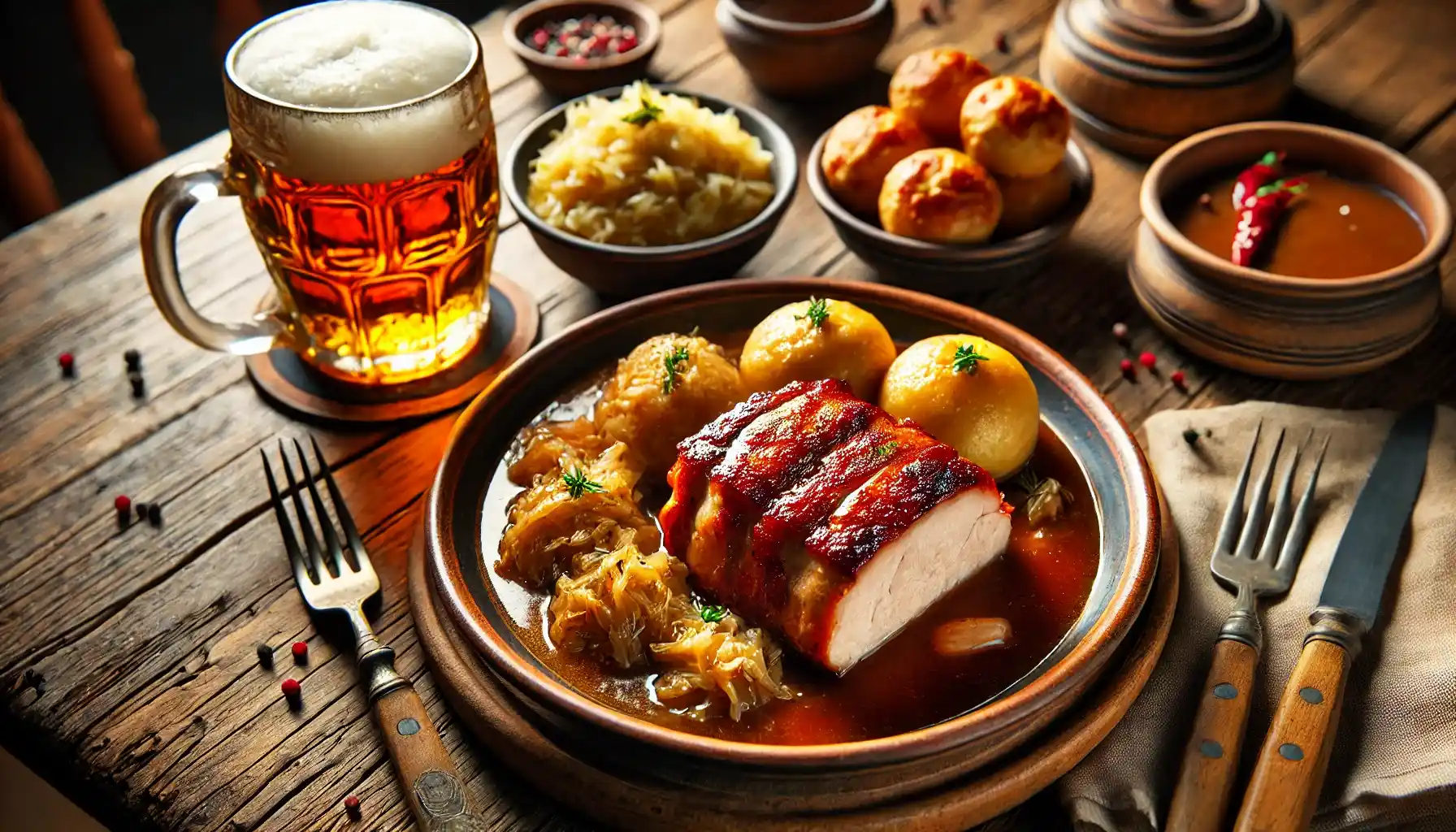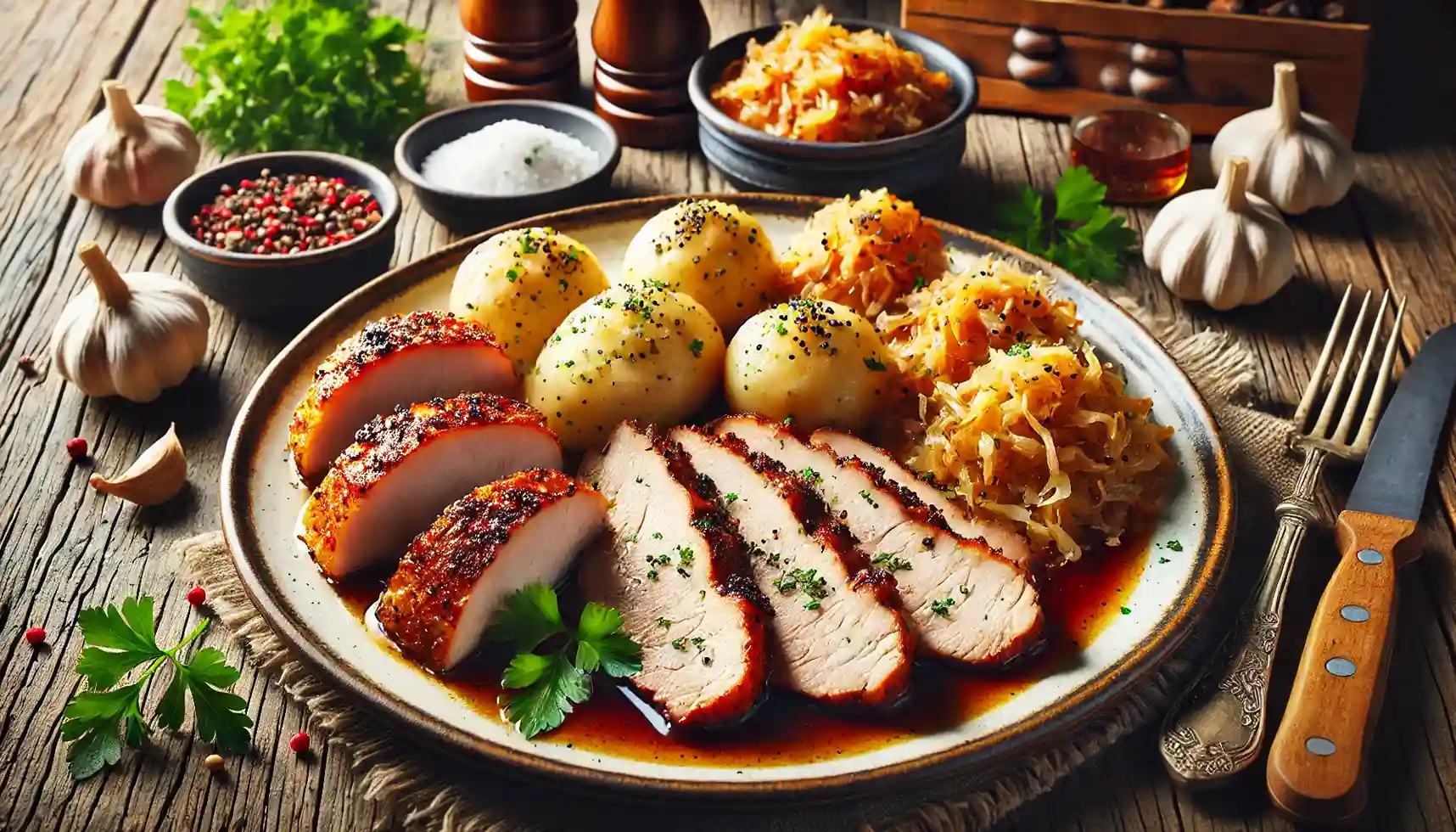Vepřo knedlo zelo is a traditional Czech dish featuring slow-roasted pork, soft dumplings, and tangy sauerkraut. This hearty and flavorful meal is a staple of Czech cuisine, offering a perfect balance of textures and tastes. Perfect for family gatherings or a taste of Central European comfort food.
Ingredients
For the roast pork:
- 1.5 kg pork shoulder or neck
- 4 cloves garlic, minced
- 2 teaspoons caraway seeds
- 1 teaspoon salt
- 1 teaspoon black pepper
- 1 large onion, sliced
- 2 tablespoons vegetable oil
- 1 cup water or broth
- 1 tbsp mustard optional
For the dumplings:
- 3 cups all-purpose flour
- 1 cup milk
- 1 egg
- 1 teaspoon salt
- 1 teaspoon baking powder
- 1 cup cubed stale bread
- 1 tbsp butter
For the sauerkraut:
- 500 g sauerkraut, drained
- 1 small onion, finely chopped
- 2 tablespoons vegetable oil
- 1 teaspoon sugar
- 1 teaspoon caraway seeds
- ½ cup water or broth
- 1 tbsp flour optional
- 1 small grated apple optional
Instructions
Roast the pork:
- Preheat the oven to 180°C (350°F).

- Rub the pork with garlic, caraway seeds, salt, and pepper. If using mustard, spread it evenly over the surface.
- In a roasting pan, heat oil and sear the pork until browned on all sides.

- Add sliced onions and pour in water or broth. Cover and roast for 2 to 2.5 hours, basting occasionally.
- Prepare the dumplings:In a bowl, mix flour, salt, and baking powder. Stir in milk and egg to form a dough, then fold in the bread cubes and butter. Shape into logs and let rest for 15 minutes. Bring a large pot of salted water to a gentle boil and cook the dumpling logs for 20 minutes, turning occasionally to ensure even cooking. Remove, let cool slightly, and slice before serving.

- Cook the sauerkraut:Heat oil in a pan and sauté the onion until golden. Add sauerkraut, sugar, caraway seeds, grated apple (if using), and water or broth. Simmer for 20 minutes, stirring occasionally. For a thicker consistency, mix flour with a little water and stir into the sauerkraut during the last few minutes of cooking.
- Assemble and serve:Slice the pork and serve with dumplings and sauerkraut, drizzling the dish with the roasting juices for extra flavor. Garnish with fresh parsley or a sprinkle of additional caraway seeds for an extra touch of authenticity.

Notes
Vepřo knedlo zelo
Czech cuisine is known for its hearty and satisfying dishes, and vepřo knedlo zelo is one of the most iconic meals in the country. This classic dish, whose name directly translates to pork, dumplings, and sauerkraut, is a perfect blend of rich, savory flavors and contrasting textures, making it a favorite among locals and visitors alike. Whether enjoyed at a cozy family dinner or served in a traditional Czech restaurant, this dish offers an authentic taste of Central Europe’s culinary heritage.The origins and cultural significance
With influences from Austrian and German culinary traditions, vepřo knedlo zelo has been a staple in Czech households for generations. Traditionally served as a Sunday meal or for special occasions, this dish embodies the warmth and simplicity of home-cooked comfort food. It is a dish deeply tied to the country’s agricultural history, where pork, cabbage, and bread have long been dietary staples. Today, it remains a beloved meal that brings families together around the dining table. While Czech cuisine features a variety of meat dishes, vepřo knedlo zelo stands out for its well-balanced combination of flavors and textures. The slow-roasted pork, accompanied by soft dumplings and tangy sauerkraut, creates a harmonious balance of flavors that represents Czech gastronomy at its finest. It is not only a satisfying dish but also a symbol of the country’s culinary identity.
While Czech cuisine features a variety of meat dishes, vepřo knedlo zelo stands out for its well-balanced combination of flavors and textures. The slow-roasted pork, accompanied by soft dumplings and tangy sauerkraut, creates a harmonious balance of flavors that represents Czech gastronomy at its finest. It is not only a satisfying dish but also a symbol of the country’s culinary identity.
A symphony of flavors
The dish revolves around three main components, each bringing its own unique character to the plate.- Roast pork: The pork is typically slow-cooked with garlic, caraway seeds, salt, and pepper, allowing the flavors to deepen and the meat to become tender and succulent. The roasting process results in a crispy, golden-brown crust that adds to the overall appeal. The meat is often basted in its own juices to ensure maximum tenderness and flavor.
- Dumplings: Known as knedlíky, these soft, pillowy dumplings are the perfect complement to the richness of the pork. Whether made from bread or potatoes, they absorb the flavorful juices of the meat and add a satisfying texture to the dish. Dumplings have long been a crucial part of Czech cuisine, and their versatility makes them a staple in many traditional meals.
- Sauerkraut: The fermented cabbage, stewed with onions and a touch of sugar, balances the meal with its acidity and mild sweetness, cutting through the richness of the pork and dumplings. It is often seasoned with caraway seeds, which add depth to the flavor and highlight the dish’s Central European roots.
A must-try Czech classic
Vepřo knedlo zelo is more than just a meal; it is a representation of Czech culinary heritage. Whether enjoyed at a family gathering or a traditional Czech restaurant, this dish continues to bring warmth and satisfaction to those who savor it. The combination of crispy, juicy pork, soft and fluffy dumplings, and tangy, flavorful sauerkraut makes for a truly unforgettable experience. Paired with a cold Czech beer or a light white wine, vepřo knedlo zelo is a prime example of Central European comfort food at its best. It is a dish that has stood the test of time, continuing to be loved by generations of Czechs and appreciated by food enthusiasts around the world. If you’re looking to explore traditional Czech flavors, this dish is an essential starting point for an authentic taste of the country’s rich culinary tradition.
Paired with a cold Czech beer or a light white wine, vepřo knedlo zelo is a prime example of Central European comfort food at its best. It is a dish that has stood the test of time, continuing to be loved by generations of Czechs and appreciated by food enthusiasts around the world. If you’re looking to explore traditional Czech flavors, this dish is an essential starting point for an authentic taste of the country’s rich culinary tradition.